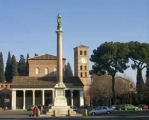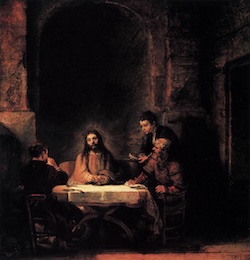» Enjoy our Liturgical Seasons series of e-books!
Today the Gospel relates the story of the disciples and Jesus on the road to Emmaus. Through the holy Eucharist we are drawn deeper and deeper into the saving death and glorious resurrection of the immortal Christ. Like Cleophas and Luke of Emmaus we are Table-guests of Christ, we know Him, our crucified and risen Lord, in the breaking of the Bread; our cold hearts begin to burn, our blind eyes are opened, and our souls are filled with that paschal peace and joy with which these two disciples hastened from Emmaus back to Jerusalem on that first blessed Easter evening. — Vine and Branches, Martin Hellriegel, 1948.
The Octave of Easter, throughout which formerly servile work was forbidden, was one continual feast in the Church's eyes. Each day the newly baptized attended Mass at a Stational Church, at which they received Holy Commmunion. In the evening they went to St. John Lateran for the office of Vespers.
Meditation for Wednesday within the Octave of Easter:
The Road to Emmaus
Today’s Gospel reading, in which St. Luke tells of the Risen Lord’s encounter with two disciples on the road to Emmaus, is one of the literary gems of the New Testament. It also summarizes neatly the long and sometimes difficult path the first witnesses to the Resurrection had to walk in order to arrive at the fullness of Easter faith.
As Luke sets the scene, there is, at first, bewilderment: things had gone terribly wrong; the one whom these disciples had hoped would “redeem Israel” had died a shameful death in which Israel’s leaders were complicit, because they regarded him as a blasphemer. Bewilderment then gives way to deeper confusion: these two anonymous disciples had heard the women’s tale of an empty tomb and a vision of angels who “said that he was alive.” But they could not grasp what this “being alive” meant, or what it had to do with the still-incomprehensible suffering and death of the one who was the “redeem Israel.”
The stranger—the Risen One—then begins to make things clear: “Beginning with Moses and all the prophets, he interpreted to them in all the scriptures the things concerning himself,” including the necessary passage through suffering of the redeemer of Israel. And yet they still did not grasp what had happened, or who this stranger was. It is only when “he took the bread and blessed, and broke it, and gave it to them” that “their eyes were opened and they recognized him.” At which point “he vanished out of their sight.” Stunned at their own blindness—“Did not our hearts burn within us while he talked to us on the road, while he opened to us the scriptures?"—they rush back to Jerusalem to make their profession of Easter faith, where they are greeted with a parallel act of faith by the Eleven and their companions: “The Lord has risen indeed, and has appeared to Simon!”
Empty tomb and appearances; Word and Sacrament; the Cross and the Resurrection: in its corporate memory of the beginnings of Easter faith, to which Luke bears witness in this marvelously crafted narrative, the Church held fast to everything that had shed light on the radically new situation of those who had met the Risen One—and those who believed the testimony of their friends who had. The Scriptures had to be read afresh, with new eyes; messianic expectations had to be recast; common acts that had once indicated table fellowship, like the breaking of bread and its blessing, now took on deeper meanings; the very idea of “history” changed, as did the idea of God’s “redemption” of Israel, which now seemed to extend beyond the familiar boundaries. Although they certainly would not have put it in these terms, the first witnesses to the Resurrection were grasping for an understanding of what Pope Benedict XVI would later describe, in Jesus of Nazareth—Holy Week, as an ”evolutionary leap” in the human condition: a qualitatively new mode of living was being revealed in the vibrant, manifestly human, but utterly different life of the Risen Lord. And that, as the Octave of Easter has taught again and again, changed everything.
In an Easter sermon with the suggestive title “The Heart of Stone Beats Again,” Hans Urs von Balthasar suggests that this particular Resurrection appearance ought to resonate in a special way with those living in late modernity, who might well recognize themselves in the disciples who wandered down the Emmaus road some two millennia ago. All of us, Balthasar notes, are in a hurry—but to where? We are all beset by “a constant stream of images” —meaning what? “There is so much hustle and bustle. What we can contain in our heads is so little, and the more that forces its way in, the less we can hold.” Busyness, we discover sooner or later, is no substitute for purposefulness. Busyness, we may even begin to suspect, is one of the psychological tricks we play on ourselves to avoid confronting the fact that we are all destined for the grave.
What, then, are we looking for, in this often aimless wandering? We are looking, the Swiss theologian suggests, for what those two confused and perplexed disciples found on the Emmaus road: “the tangible reality of resurrection from the dead.” And this is what Christians have found:
One man has come back, not a spiritist phenomenon but in flesh and blood: “Touch me and see; for a spirit has not flesh and bones as you see that I have.” He did not come back as a projection of the living faith of his disciples, for he came when none of them had the least idea of such a possibility, and he had a hard battle against their stubborn unbelief. This One Man has brought back with him from the realm of the dead the hope and certainty of eternal life for all. He brings us the very thing we need, although we cannot see how, namely, a continuing life that is not simply a continuation of the old life….A continuing life, but not totally new and different either—a new form of cosmic life on some other planet, for instance—for that would be no solution and we would no longer be ourselves. It is both things at the same time, therefore, and in a way that is beyond our imagining: both a transition into God’s eternity and at the same time the transfiguration and fulfillment of all that remained hopelessly unfulfilled and unfulfillable on earth. This wonderful, unique, earthly life, purified of all its slag, it to be lifted up the plane of the eternal.
The challenge today, as for the disciples en route to Emmaus, is to overcome our disbelief that anything could be so good, so true, so beautiful. That radical quality of the New Life promised by Easter faith, Balthasar suggests, is why Christians are dangerous, and why Christians are persecuted. “Right from the beginning,” he writes, “Christianity was seen as a total, highly dangerous revolution.” Once, in the days of St. Lawrence, whose major station is revisited today, it challenged Roman authorities, who were convinced that the cult of the gods was necessary for public order. Now, it challenges cultures committed to skepticism and its moral offspring, relativism.
One might think that, because Christianity proclaims what Balthasar calls “meaning’s revolt against the meaninglessness of dying,” its proclamation would be eagerly embraced. But to imagine that is to misgauge the darkening of mind and hardening of will that is humanity’s enduring legacy from our first parents. The “revolt of the Resurrection against the finality of bodily disintegration” suggests that the body has an eternal destiny and is not merely a tool to be used as whim dictates here and now; and that very concept challenges the hedonism of the twenty-first century. The ”revolt of love’s absoluteness against any resignation on the part of the heart” challenges twenty-first century cynicism, which confuses love with pleasure and finds it hard to imagine permanence in love.
The Emmaus story ought also to be reassuring to Christians at those moments when faith falters. As pilgrims have discovered along the Lenten itinerary of conversion, the momentum in Luke’s gospel is always toward Jerusalem; thus, the two disciples in today’s Easter story are walking in the wrong direction—away from Jerusalem, and away from the Cross. Yet their misdirection is repaired by the Risen One, who walks with them as he walks with us, even when we are headed in the wrong direction. He walks with us in the Scriptures and in the Holy Eucharist; he walks with us into the confessional; and in that pastoral accompaniment, he points us back to the right path—the path to the New Jerusalem.
The Resurrection changes everything. Little wonder that it took so long for the disciples to recognize the Risen One and to grasp what had happened to him, and to them. Little wonder that it takes a lifetime of faith to begin to grasp the meaning of Easter faith today. Amid that struggle to understand, however, the Risen Lord walks with those whose hearts burn within them, yearning for the embrace of the love that can never die again because, as suffering love, it has passed through death and has conquered.
That is the testimony in the First Letter of Peter in the Office of Readings, and it remains as true today as when the first leaders of the Church preached to the newly baptized two millennia ago: “Christ…suffered for you, leaving you an example, that you should follow in his steps. He committed not sin….He himself bore our sins in his body on the tree, that we might die to sin and live to righteousness. By his wounds you were healed. For you were straying like sheep, but have now returned to the Shepherd and Guardian of your souls.”
—George Weigel, Roman Pilgrimage: The Station Churches

Wednesday in the Octave of Easter
Station with San Lorenzo fuori le Mura (St. Lawrence Outside the Walls):
At Rome, the Station is in the basilica of St. Lawrence, Outside the Walls. It is looked upon as the most important of the many churches built by Rome in honor of her favorite martyr, whose body lies under the high altar. The newly baptized were led here today that they might learn, from the example of so brave and generous a soldier of Christ, how courageous they should be in confessing their faith, and how faithful in living up to their baptismal vows.
For more on San Lorenzo fuori le Mura, see:
For further information on the Station Churches, see The Stational Church.






